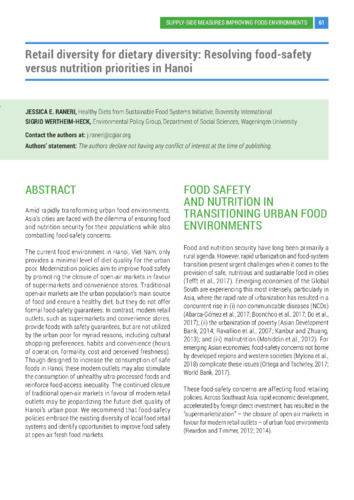Retail diversity for dietary diversity: Resolving food-safety versus nutrition priorities in Hanoi
Amid rapidly transforming urban food environments,
Asia’s cities are faced with the dilemma of ensuring food
and nutrition security for their populations while also
combatting food-safety concerns.
The current food environment in Hanoi, Viet Nam, only
provides a minimal level of diet quality for the urban
poor. Modernization policies aim to improve food safety
by promoting the closure of open-air markets in favour
of supermarkets and convenience stores. Traditional
open-air markets are the urban population’s main source
of food and ensure a healthy diet, but they do not offer
formal food-safety guarantees. In contrast, modern retail
outlets, such as supermarkets and convenience stores,
provide foods with safety guarantees, but are not utilized
by the urban poor for myriad reasons, including cultural
shopping preferences, habits and convenience (hours
of operation, formality, cost and perceived freshness).
Though designed to increase the consumption of safe
foods in Hanoi, these modern outlets may also stimulate
the consumption of unhealthy ultra-processed foods and
reinforce food-access inequality. The continued closure
of traditional open-air markets in favour of modern retail
outlets may be jeopardizing the future diet quality of
Hanoi’s urban poor. We recommend that food-safety
policies embrace the existing diversity of local food retail systems and identify opportunities to improve food safety at open-air fresh food markets.

